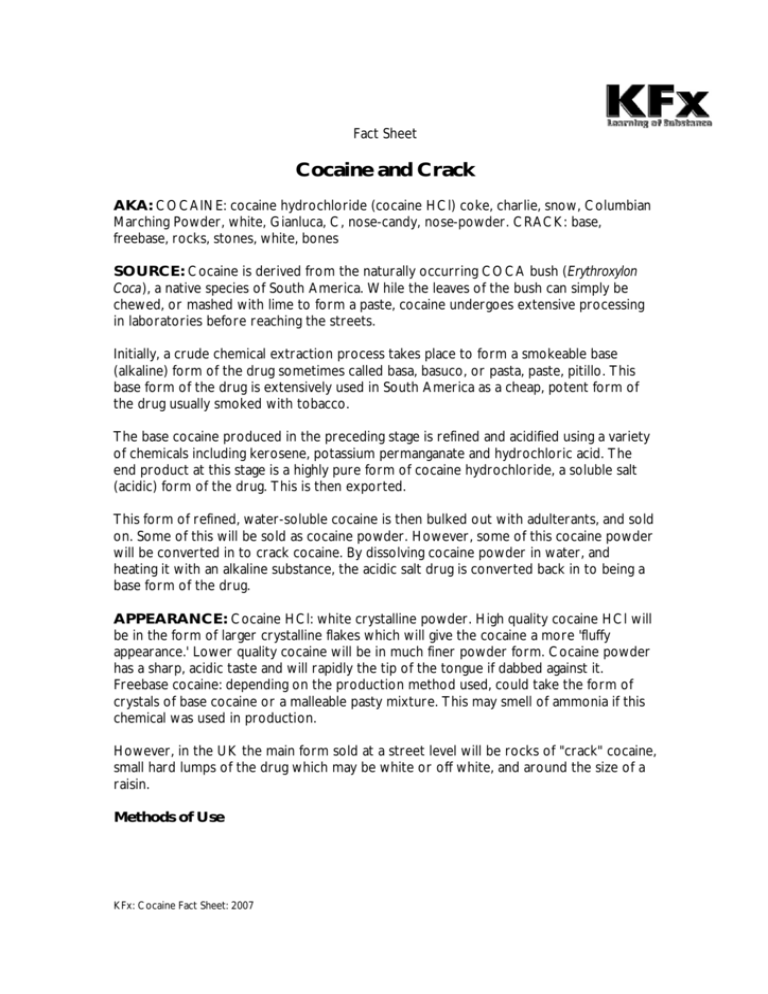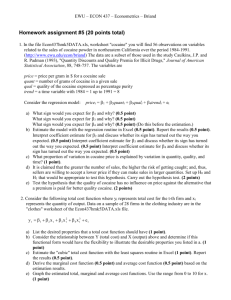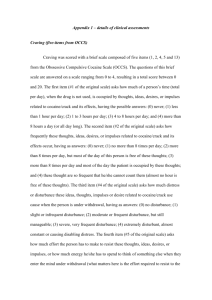Cocaine and Crack
advertisement

Fact Sheet Cocaine and Crack AKA: COCAINE: cocaine hydrochloride (cocaine HCl) coke, charlie, snow, Columbian Marching Powder, white, Gianluca, C, nose-candy, nose-powder. CRACK: base, freebase, rocks, stones, white, bones SOURCE: Cocaine is derived from the naturally occurring COCA bush (Erythroxylon Coca), a native species of South America. While the leaves of the bush can simply be chewed, or mashed with lime to form a paste, cocaine undergoes extensive processing in laboratories before reaching the streets. Initially, a crude chemical extraction process takes place to form a smokeable base (alkaline) form of the drug sometimes called basa, basuco, or pasta, paste, pitillo. This base form of the drug is extensively used in South America as a cheap, potent form of the drug usually smoked with tobacco. The base cocaine produced in the preceding stage is refined and acidified using a variety of chemicals including kerosene, potassium permanganate and hydrochloric acid. The end product at this stage is a highly pure form of cocaine hydrochloride, a soluble salt (acidic) form of the drug. This is then exported. This form of refined, water-soluble cocaine is then bulked out with adulterants, and sold on. Some of this will be sold as cocaine powder. However, some of this cocaine powder will be converted in to crack cocaine. By dissolving cocaine powder in water, and heating it with an alkaline substance, the acidic salt drug is converted back in to being a base form of the drug. APPEARANCE: Cocaine HCl: white crystalline powder. High quality cocaine HCl will be in the form of larger crystalline flakes which will give the cocaine a more 'fluffy appearance.' Lower quality cocaine will be in much finer powder form. Cocaine powder has a sharp, acidic taste and will rapidly the tip of the tongue if dabbed against it. Freebase cocaine: depending on the production method used, could take the form of crystals of base cocaine or a malleable pasty mixture. This may smell of ammonia if this chemical was used in production. However, in the UK the main form sold at a street level will be rocks of "crack" cocaine, small hard lumps of the drug which may be white or off white, and around the size of a raisin. Methods of Use KFx: Cocaine Fact Sheet: 2007 Cocaine HCl is water soluble and can be absorbed across a mucous membrane (e.g. nose, gums). It is often snorted, or rubbed in to gums. Typically, when snorted, the powdered drug is placed on a flat surface; the crystals are made as fine as possible by chopping them with a credit card. The resulting powder is then snorted, often through a tube of rolled-up paper in to the nostril. It dissolves, enters the capillaries and then passes in to the circulatory system. Cocaine HCl can also be injected. It does not lend itself to smoking as the heat of a cigarette or pipe will cause the cocaine to breakdown, rather than vapourising. Hence this is an inefficient method of use. Crack cocaine has a lower melting point (95C) than cocaine HCl and so it can be smoked. This is usually done through a pipe, though some people flake crack in to spliffs and smoke it this way. As crack is not water soluble it cannot be snorted or injected. In order to inject it, some users will acidify crack cocaine, turning it back in to watersoluble salt. COSTS: Cocaine is typically sold by weight, crack by the rock. A single rock of crackcocaine can cost as little as £5 or as much as £20, but a great deal is sold at around £10 a rock. Price varies with size of the rock, quality, availability and region. A gramme of cocaine costs between £40 and £80, though cocaine is sold at higher and lower prices. QUALITY: While cocaine powder is easily cut with other adulterants, purity tends to be higher than, for example, speed. Adulterants include mannitol, sorbitol, amphetamine, lactose, caffeine, lidocaine, benzocaine. Crack purity will depend on the strength of the cocaine used and the process used. Much literature claims that crack is a purer drug than cocaine HCl and this is not always the case. Crack can be made in a one-stage or two stage process. A one stage process simply converts the drug from a salt to a base, but does not make it any purer. A two-stage process will convert the drug from salt to base but also refine it. Most mass-produced crack is produced in a one-step process and so the crack will be of a similar (or lower) purity than the cocaine from which it was manufactured. The crack will only be purer if adulterants present in the cocaine were removed. Regardless, crack will inevitably feel stronger due to the route of administration. Drugs which are smoked deliver more of the drug to the brain more rapidly than drugs which are snorted. EFFECTS: Cocaine is a powerful stimulant; it offers an intense impression of power and control, combined with heightened energy and awareness. Users can feel euphoric, sexually aroused, confident and egotistical. KFx: Cocaine Fact Sheet: 2007 It is, in some respects, similar to speed, but offers a more euphoric and less "harsh" experience. Effects also include increased heart-rate and blood pressure, and pupil dilation. Users are apt to become restless and talkative. When cocaine is injected, snorted, or rubbed onto the gums, it causes numbing of the site. Cocaine also alleviates the need for sleep, and acts as a powerful appetite suppressant. Duration of effects depends largely on what is being used and how it is used. Cocaine which is snorted takes longer to act than cocaine injected, but the effects last longer. Crack, on the other hand, takes effect almost immediately when smoked, but the effects wear off rapidly, typically within 15 minutes. This rapid up-and-down encourages users to take the drug again straight away, and can lead to binges, where a user will take rock after rock, postponing the comedown, until they run out of money and drugs. HEALTH IMPLICATIONS: With short-term use, cocaine users can experience anxiety, paranoia and disrupted sleep. The suppression of appetite can lead to weight loss, and users will experience exhaustion and fatigue. Snorting of cocaine can lead to perforation of the septum, and rubbing cocaine into the gums can cause gum disease and cavities. Crack smokers often experience bronchial problems, exhibited by coughing and black phlegm. Regular use can cause anxiety, depression and ultimately psychosis. Deaths do occur, predominantly through heart failure or haemorrhages. Cocaine used in conjunction with alcohol forms a compound called cocaethylene; this compound increases the strain on the liver and regular use of cocaine with alcohol increases the risk of liver damage. Cocaine used in combination with other drugs that elevate blood pressure increases the risk of serious health problems. Some users end up using other drugs such as benzodiazepines to offset the come-down caused by excessive cocaine use. An increasingly large population is using cocaine alongside heroin, sometimes smoked but increasingly injecting both drugs together (snowballing). This brings with it the risks of dependency associated with heroin use alongside the risks and costs of a cocaine habit. Cocaine is not thought to be physically addictive. However, the intensely pleasurable high and the less pleasurable comedown can lead to regular and increasingly problematic use. The very rapid high and comedown from crack increases the likelihood of dependency. KFx: Cocaine Fact Sheet: 2007 LEGAL STATUS: Cocaine is a Class A, Schedule 2 drug; some derivatives of cocaine are still used as local anaesthetics. OTHER INFORMATION: Cocaine HCl has been one of the few illicit drugs to buck the trends in the UK and increase in popularity over the past few years. Cocaine currently enjoys a relatively low cost, high availability and an unrivalled "popular" profile and so has achieved a relatively high level of social acceptability. It is used across a wide range of social demographics, enjoying popularity amongst people in the manual trades, clubbers, media, city, young people, and professionals from a range of backgrounds. At present the glamour and acceptability of cocaine appears to have the upper-hand and concerns around dependency, physical or psychological harm or the problems associated with the international cocaine trade appear to have little deterrent effect. Crack use on the other hand has not enjoyed the same level of acceptable. Crack use has become more widespread in the UK and over the past ten years, availability and use has increased significantly. Much of this expansion has been within existing heroin markets, so markets which were once exclusively heroin markets are now heroin and crack markets. Effectively the cocaine market is fairly polarised in the UK now, with cocaine powder use becoming relatively socially accepted and widespread, whilst crack use is relatively restricted in its usage and acceptability. Strictly speaking, crack is not a new drug, nor is it a different drug from cocaine. It has been chemically treated to "free the base from the salt," which allows it to be smoked. Freebasing, which was a low-scale cottage industry in the States in the Seventies really took off with the development of crack production and sale in the 90s. The processing of cocaine into crack is very simple. It is not true to suggest that crack is cheaper than cocaine. Weight for weight, crack is more expensive than cocaine powder. In addition, smoking crack is a more wasteful method of use. However, its rapid, intense rush and relative cheapness per rock makes it more appealing to new users. This relative cheapness however is offset by the short duration for which the effects last, and the strong compulsion that many users experience to have another rock. Anecdotes are legion in the drugs field of users spending thousands of pounds in binges lasting several days, and of people becoming rapidly involved in crime, dealing or the sex-industry to pay for their crack. Drug services have been slow in creating effective services for people with cocaine, and especially crack-related issues. KFx: Cocaine Fact Sheet: 2007







